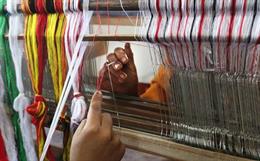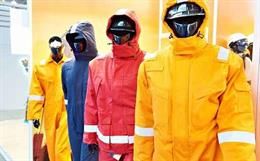Opportunityonce missed is an opportunity lost forever So before we miss any of theopportunity of being a leading player in nonwovens, we need to capitalize it.
Indiais just thinking of fighting for the status of a developed country whereglobalization will play an important role. The Indians need to be global in allrespect from hygiene to infrastructure and from sports to high-tech engineeredproducts. However, I feel the issue is of changing our mind set from being "Conventional"to "state-of-the art". We need to change ourselves from basics tovalue added products and shifting our focus from commodities to niche markets.
Formore than 100 years, we are catering to our own large population for theirclothing needs; however, thought of adopting approach towards high technonwovens would certainly create a new road map for our industry.
TheIndian culture is in transition phase and the new generation entrepreneursshould think of unexploited market segments. As we are going towards globalization,our needs and market demands will get changed and I am sure the products likewet wipes, disposable home textiles, travel kits, air bags, high end sportstextiles, disposable products like medical textiles and home textiles will beproducts of daily consumption in near future. New nonwoven technologies aregoing to bring these innovative products and moreover they may replace productsof conventional technologies.
Weneed to understand our weak links in marketing, timely supply of goods,supplying products for niche markets, consistency in quality goods, after salesservice to the customers, understanding customer needs, compromising on supplychain management, etc.
• Opportunities
We are one of the largest economies in the world. We have many opportunities which can open the doors to new market segments, highly engineered products. With new developments a great demand would be created for products which are used by developed countries. We have tremendous potential to become the leading producer of nonwovens. Government has been taking important steps in promotion of nonwovens. Awareness of nonwovens in healthcare, agriculture & industrial sector is growing with much faster pace.
Nonwovens a better proposition for India
By now all of us are aware that nonwoven technologies are compact technologies and give much higher production and are emerging technologies to produce complex products as well. As the process is very short, the utility consumption is much lower and due to huge production, the operating costs are minimal. Moreover, there is hardly involvement of human beings and hence quality is determined by technology and very less chance for human interference.
In India only 12% of Technical Textiles products are manufactured by Nonwoven technology as compared to 24% of usage in the world. So India still has long way to go to meet global requirements of nonwovens. It's time to understand what Nonwovens are, what their properties are, how they are manufactured, what their applications are & most importantly what is a market potential for them?
Nonwoven technologies & potential markets for India
Historically, India is and was always very strong with its ability to produce cotton base products. Even though there is a less scope for cotton based products in overall nonwovens, India has much better chance than any other countries. Moreover, I have noticed one thing that in the international market the other countries find it very difficult to handle cotton in to various finished products of nonwovens. They have done very little efforts in R&D activities for cotton. Indian entrepreneurs can very well enter in to this segment in a big way and start replacing market of other fibres as well. Due to inherent qualities of cotton it would be preferred over other fibres in most of the applications. Major Nonwoven categories are needle-punched, spunlace & spunbond. Their consumption is growing rapidly because of their increasing industrial as well as household applications on day to day basis.
Needle punched Nonwovens
They have wide range of applications and usually heavier products. They are used in around 40 parts of automotives. Considering India's huge automotive market which is estimated to grow with CAGR of 13%, nonwovens consumption is going to grow exponentially. Geosynthetics is another segment where there are tremendous investments opportunities considering increasing growth in infrastructure & real estate in India as well as worldwide. Nonwoven materials used in filtration applications are an important part of the worldwide Nonwoven industry. Industrial wipes are used for a variety of applications in industry and institutions; including food service wipes, general industrial and specialty wipes and medical wipes. Global demand for flooring and carpets is expected to grow.
Spunlace Nonwovens
Spunlace technology facilitates highest flexibility and achieves much wider product range with most compact process. Global exports of spunlace nonwoven are increasing at a CAGR of 8%. Indias exports of spunlace nonwoven are increasing rapidly in last few years. Spunlace nonwovens are used mainly for various low weight products by using natural fibres without deteriorating their physical properties. Spunlace nonwovens are also used in roofing substrates, consumer wipes, cotton pads, surgical disposables, etc. Growing population & growing markets of beauty & hygiene products will certainly increase demand of spunlace nonwovens in India.
Growth drivers for nonwoven market
Nonwoven market is expected to reach USD 45,363 millions by 2019, growing at a CAGR of 6.7% from 2013 to 2019, so nonwovens is a big opportunity for Indian Textile Industry, as it has tremendous potential to grow in India as well as in global markets in future. The major growth drivers are:
• Increasing population
• Disposable income
• Changing lifestyles
• Awareness of healthcare & hygiene products
Other drivers are steady increase in Infrastructure development, real estate growth, growth in geotextile consumption, industrial growth, growth in automotive sectors, urbanization, stringent laws on waste management & popularity of various sports also contributing in rise in demand of geotextiles.
Road map to get in to Nonwovens
"Marketing" is the biggest hurdle in front of nonwoven industry. It has to be cleared before we miss the opportunity and for that initiatives should be taken at all levels from Government to textile societies, media and possibly all promotional platforms like textile exhibitions and events along with direct marketing.
First and foremost thing is that we need to do our "homework" in more professional manner. Emphasis should be given to various business opportunities available in nonwoven sector & possible markets which can be explored. We need to map our strengths with the market gaps. Choose a product basket which would be more focused yet flexible and devise our strategy with business plan and projections for 10 years.
Conclusion
We have all the resources from raw material to work force. What we lack is marketing strategy and technology awareness. Investors can take professional help from consulting firms having expertise & technical knowledge of nonwoven technologies. Investors have to be clear in their mind with a market entry strategy & the product mix of their interest and choice. With the professional help, they can even evaluate different business options & select most suitable one.
It's time to assess huge demand-supply gap in nonwoven industry & choose a right path with highly professional strategy.
About the author
Avinash Mayekar is the Managing Director & CEO of Suvin Advisors Pvt. Ltd Suvin Advisors Pvt. Ltd. is one of the rare organizations offering the entire range of management and engineering consultancy services from business strategies to overall project implementation to process improvisation in existing units. Suvin offers services in various sectors like textile (major thrust on technical textiles), food, education, healthcare, hospitality, other industrial and infrastructure projects.







